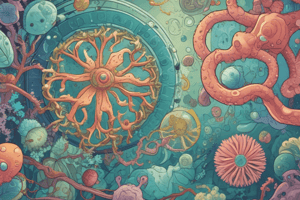Podcast
Questions and Answers
What is the primary focus of microbiology?
What is the primary focus of microbiology?
- The study of macroorganisms
- The study of microorganisms (correct)
- The study of plant life
- The study of animal life
Which of the following is NOT a type of microorganism?
Which of the following is NOT a type of microorganism?
- Fungi
- Reptiles (correct)
- Archaea
- Bacteria
When did the concept of microorganisms first emerge?
When did the concept of microorganisms first emerge?
- 5th century BC
- 17th century AD
- 13th century AD (correct)
- 10th century AD
Who is credited with confirming the existence of living organisms invisible to the naked eye?
Who is credited with confirming the existence of living organisms invisible to the naked eye?
When did microbiology become a formal scientific discipline?
When did microbiology become a formal scientific discipline?
Which of the following areas is NOT mentioned as benefiting from the study of microorganisms?
Which of the following areas is NOT mentioned as benefiting from the study of microorganisms?
Which of the following is NOT a main category of microorganisms?
Which of the following is NOT a main category of microorganisms?
What is a significant role played by archaea?
What is a significant role played by archaea?
Which field does NOT utilize the study of microorganisms?
Which field does NOT utilize the study of microorganisms?
What is the primary role of protozoa in ecosystems?
What is the primary role of protozoa in ecosystems?
Which of the following is NOT mentioned as an application of microbiology?
Which of the following is NOT mentioned as an application of microbiology?
What is the primary function of viruses in the context of microbiology?
What is the primary function of viruses in the context of microbiology?
Study Notes
Microbiology: The Study of Microorganisms
Introduction
Microbiology, simply put, is the study of microorganisms. These microscopic life forms come in various types, including bacteria, archaea, fungi, protists, and viruses. Microorganisms are essential to life on Earth and have critical roles in areas like medicine, agriculture, and environmental health.
Historical Development of Microbiology
The concept of microorganisms dates back to the 13th century when people started speculating about invisible entities responsible for decay and disease. However, it wasn't until the 17th century that the existence of living organisms invisible to the naked eye was confirmed. The term "microbe" was coined in the late 19th century, encompassing all these tiny life forms initially believed to be closely related.
In the late 19th century, scientists began using microscopes to observe these previously unseen organisms. One notable figure in this area was Antonie van Leeuwenhoek, a Dutch merchant who created high-quality lenses. He observed various types of bacteria, protozoans, and diatoms, documenting his discoveries through detailed drawings.
Microbiology became a formal scientific discipline around the start of the 20th century. During this period, key figures like Koch, Pasteur, and their students developed methods for identifying and categorizing microbes. Major breakthroughs involving bacteriology, virology, and other branches of microbiology followed.
By the end of the 20th century, microbiology had expanded beyond its initial focus on disease-causing organisms to encompass a broader understanding of all microorganisms and their roles in nature. It has also led to the development of techniques to manipulate and utilize these microorganisms for various purposes.
Types of Microorganisms
There are several main categories of microorganisms:
- Bacteria: Single-celled prokaryotes widely distributed in all ecosystems, playing crucial roles in decomposition, nutrient cycling, and biogeochemistry.
- Archaea: Similar to bacteria but adapted to extreme environments such as hot springs, deep-sea vents, and salt flats. Some archaea are involved in methane production.
- Fungi: A diverse group including yeasts, molds, and mushrooms. They decompose organic matter, produce antibiotics, and are used for food production.
- Protozoa: Unicellular eukaryotes responsible for various roles in ecosystems, including decomposition, nutrient cycling, and predation on other protozoa.
- Viruses: Non-cellular infectious agents that require host cells to reproduce. They have significant impacts on the health of plants and animals.
Applications of Microbiology
The study of microorganisms has numerous applications across various fields:
- Medical Sciences: Understanding the structure and function of microbes helps us understand diseases they cause or protect against, leading to advancements in treatments and preventive measures.
- Environmental Health: Microbiology helps manage water pollution, monitor air quality, and study soil health. It also plays a crucial role in understanding ecological processes and biodiversity.
- Biotechnology: Microbes are used for large-scale production of substances like enzymes, antibiotics, biofuels, and other commercial products.
- Food Industry: Microorganisms play essential roles in food processing, preservation, and taste enhancement.
- Plant Pathology: The impact of microbes on plant growth and disease is key to sustainable agriculture.
- Space Exploration: Studying extremophiles can inform our understanding of life beyond Earth and assist in finding signs of extraterrestrial life.
In summary, microbiology is the study of microorganisms that thrive everywhere around us. With its historical roots dating back centuries, it has evolved into a vibrant field with far-reaching implications for medicine, industry, and the environment. Continued research will undoubtedly lead to new discoveries and applications in this dynamic area of science.
Studying That Suits You
Use AI to generate personalized quizzes and flashcards to suit your learning preferences.
Description
Test your knowledge about microbiology, the science dedicated to studying microorganisms such as bacteria, archaea, fungi, protists, and viruses. Explore the historical development, types of microorganisms, and applications of microbiology in various fields like medicine, agriculture, and environmental health.




